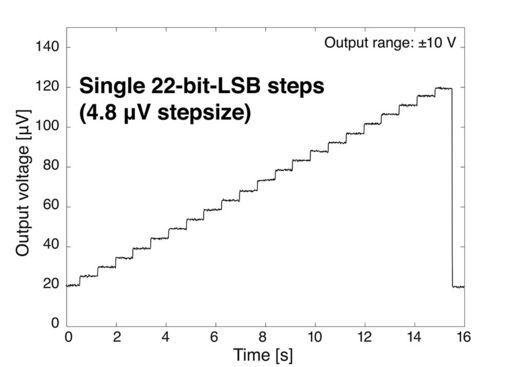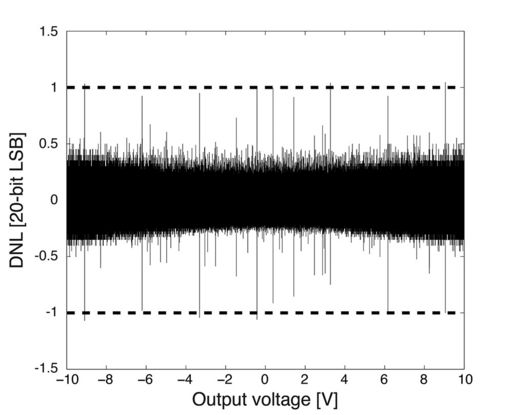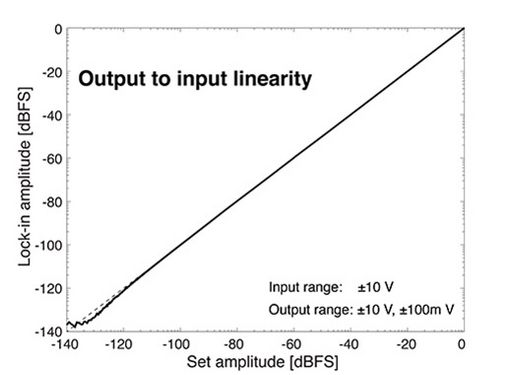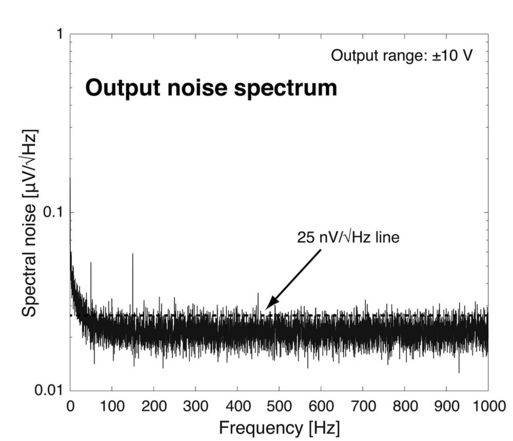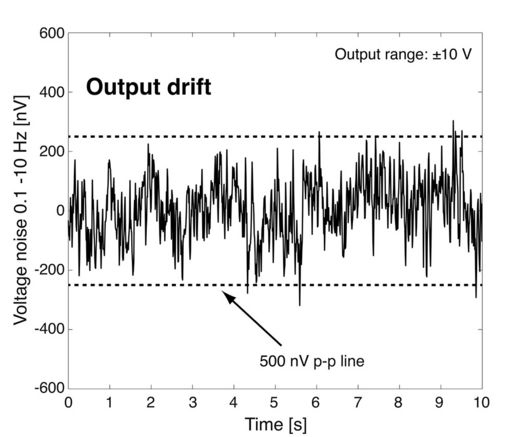
High resolution DA conversion
Nanonis Tramea™ uses the fastest 20-bit, 1-ppm Digitial to Analog converters available on the market. The patented hrDAC technology transforms these state-of-the-art converters into even higher resolution 22-bit devices.
- True 20-bit native resolution on every output
- 22-bit resolution with hrDAC, individually selectable for each output. Stepsize down to 5 μV with an output range of ±10 V.
- Fully AC-capable with 40 kHz analog bandwidth
- Smallest amplitudes possible, therefore no mixers required for DC+AC operation
High precision
Still using 16-bit converters because higher resolution DACs have poor precision?
It is no longer necessary to choose between high-resolution or high-precision outputs. The Nanonis Tramea™ outputs feature true 20-bit precision, meaning impressive 1 ppm maximum error.
- INL error of 1 20-bit LSB (typical) meaning maximum deviation of 1 ppm from ideal behavior
- DNL of 0.5 20-bit LSB (typical) resulting in highly constant step size over the full output range
- High linearity down to -120 dBFS for exceptional small signal performance
- 1 MS/s sampling rate for dynamically changing signals (lock-in, arbitrary waveforms, pulsed-gate,...)
High resolution AD conversion
A custom-designed input stage followed by 18-bit Analog to Digital converters allows the acquisition even of the weakest analog signals while using the full input range of ±10 V. Conventional instruments would require gain switching to achieve similar results.
- 18-bit input resolution at 1 MS/s
- 22-bit ENOB at 1 kS/s
- 100 kHz analog bandwidth
- High linearity for the precise acquisition of small amplitude signals. No gain switching required.
Low noise
When experiments require energies of just a few μeV, low noise is mandatory. The Nanonis Tramea™ outputs have an extremely low noise floor below 25 nv/√Hz at ±10 V output range.
- 25 nV/√Hz with ±10 V output range
- Less than 170 nV RMS noise 0.1 - 10 Hz with ±10 V output range
- Less than 10 μV RMS noise 10 Hz - 300 kHz with ±10 V output range
Low drift with temperature stabilization
Transport measurements can take a very long time and it is of utmost importance to keep all signals applied to the sample as stable as possible for the duration of the measurement. The voltage reference of the analog electronics is temperature-stabilized for lowest drift and the lowest temperature coefficient. The relative drift between different channels of the same TSC is also minimized.
- Less than 1.5 μV drift in 12 hours
- Less than 3 μV/°C temperature coefficient
High dynamic reserve for lock-in measurements

To achieve the precision required for small-signal lock-in measurements, the signal processing of the Nanonis Tramea lock-in modules uses advanced filtering. Measuring sub-mV AC signals while applying DC offsets and other AC signals up to the full 10 V input range is no longer an issue.
The measured dynamic reserve exceeds 100 dB, only limited by input noise, and the steep filtering makes sure that the maximum dynamic reserve is mantained even if frequency separation is very small
Filter architecture features to maximize signal precisions include:
- Low-pass filters up to 8th order
- Wide range of time constants
- Sync-filtering over the full lock-in frequency range
- AC-coupling with user-selectable high-pass corner frequency
